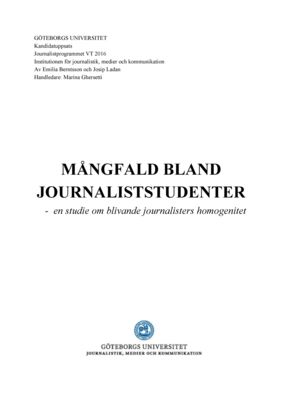MÅNGFALD BLAND JOURNALISTSTUDENTER
En studie om blivande journalisters homogenitet
The purpose of this study is to examine the diversity among Swedish journalism students and compare that result with journalists in general and also with the public. Our definition of diversity and the parts that we examined in this study is gender or transgender identity, ethnicity, religion or other beliefs, physical or mental disabilites, sexual orientation, age, place where one grew up, class background, parents ethnicity and political views.
There is a lot of research about the diversity among journalists in Sweden, and also about the diversity among students in general but not a lot about the journalism students. Therefore we wanted to fill this research gap. Journalistunderökningen (the journalist survey) from 2011 was our starting point and the research that we compared our own results with. In order to find out more about the journalism students we designed our own online survey, with a lot of the same questions as in Journalistundersökningen, which we emailed to different schools, both Universities and Community Colleges. We got 216 answers from students all over Sweden.
To help us understand our results we used Pierre Bourdieu’s theories about social fields and how different kinds of capital put you in different locations in a certain field. We also used theories from the sociology to understand how people develop and gets acclimated to their surroundings.
Our results, which are only trends and indicative results because of the low response rate, tell us that not much has changed or will change in the nearest future about what kind of persons become journalists. Journalism students are very much like the active journalists in pretty much everything except from free time activities where the students may drink and party a little bit more, which can be explained from the fact that they are students and therefor generally a little bit younger . Other than that both groups look very much alike, in everything from political views to ethnicity.
Our conclusion is therefore that there is still a lot to be done to help the diversity grow among journalists and the place to start is with the journalism students. But how can that be done?
That’s a great starting point for a new study.
Key words: journalism students, diversity, social fields, socialisation, homogenity
Nyckelord: journaliststudenter, mångfald, sociala fält, socialisation, homogenitet

